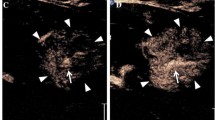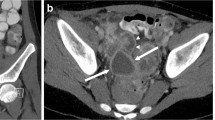Abstract
Contrast-enhanced ultrasonography (US) has become an important supplementary tool in many clinical applications in children. Contrast-enhanced voiding urosonography and intravenous US contrast agents have proved useful in routine clinical practice. Other applications of intracavitary contrast-enhanced US, particularly in children, have not been widely investigated but could serve as a practical and radiation-free problem-solver in several clinical settings. Intracavitary contrast-enhanced US is a real-time imaging modality similar to fluoroscopy with iodinated contrast agent. The US contrast agent solution is administered into physiological or non-physiological body cavities. There is no definitive list of established indications for intracavitary US contrast agent application. However, intracavitary contrast-enhanced US can be used for many clinical applications. It offers excellent real-time spatial resolution and allows for a more accurate delineation of the cavity anatomy, including the internal architecture of complex collections and possible communications within the cavity or with the surrounding structures through fistulous tracts. It can provide valuable information related to the insertion of catheters and tubes, and identify related complications such as confirming the position and patency of a catheter and identifying causes for drainage dysfunction or leakage. Patency of the ureter and biliary ducts can be evaluated, too. US contrast agent solution can be administered orally or a via nasogastric tube, or as an enema to evaluate the gastrointestinal tract. In this review we present potential clinical applications and procedural and dose recommendations regarding intracavitary contrast-enhanced ultrasonography.







Similar content being viewed by others
References
Yusuf GT, Fang C, Huang DY et al (2018) Endocavitary contrast enhanced ultrasound (CEUS): a novel problem solving technique. Insights Imaging 9:303–311
Riccabona M, Coley B (2014) US-guided interventions. In: Riccabona M (ed) Pediatric ultrasound: requisites and applications, 1st edn. Springer, Berlin, pp 60–75
Nagy E, Riccabona M (2019) Sonographic enema (“hydrocolon”) for the assessment of colonic pathology: case series to demonstrate the feasibility in neonates and infants. Pediatr Radiol 49:S285–S286
Heinzmann A, Müller T, Leitlein J et al (2012) Endocavitary contrast enhanced ultrasound (CEUS) — work in progress. Ultraschall Med 33:76–84
Huang DY, Yusuf GT, Daneshi M et al (2017) Contrast-enhanced US-guided interventions: improving success rate and avoiding complications using US contrast agents. Radiographics 37:652–664
Menendez-Castro C, Zapke M, Fahlbusch F et al (2017) Microbubbles in macrocysts — contrast-enhanced ultrasound assisted sclerosant therapy of a congenital macrocystic lymphangioma: a case report. BMC Med Imaging 17:39
Colleran GC, Paltiel HJ, Barnewolt CE, Chow JS (2016) Residual intravesical iodinated contrast: a potential cause of false-negative reflux study at contrast-enhanced voiding urosonography. Pediatr Radiol 46:1614–1617
Ključevšek D, Pečanac O, Tomažič M, Glušič M (2019) Potential causes of insufficient bladder contrast opacification and premature microbubble destruction during contrast-enhanced voiding urosonography in children. J Clin Ultrasound 47:36–41
Zheng R, Xu E (2013) Intracavitary contrast-enhanced ultrasound. In: Weskott HP (ed) Contrast-enhanced ultrasound, 2nd edn. UNI-MED Verlag, Bremen, pp 214–221
Sidhu PS, Cantisani V, Dietrich CF et al (2018) The EFSUMB guidelines and recommendations for the clinical practice of contrast-enhanced ultrasound (CEUS) in non-hepatic applications: update 2017 (short version). Ultraschall Med 39:154–180
Daneshi M, Yusuf GT, Fang C et al (2019) Contrast-enhanced ultrasound (CEUS) nephrostogram: utility and accuracy as an alternative to fluoroscopic imaging of the urinary tract. Clin Radiol 74:167.e9–167.e16
Papadopoulou F, Ntoulia A, Siomou E, Darge K (2014) Contrast-enhanced voiding urosonography with intravesical administration of a second-generation ultrasound contrast agent for diagnosis of vesicoureteral reflux: prospective evaluation of contrast safety in 1,010 children. Pediatr Radiol 44:719–728
Darge K, Papadopoulou F, Ntoulia A et al (2013) Safety of contrast-enhanced ultrasound in children for non-cardiac applications: a review by the Society for Pediatric Radiology (SPR) and the International Contrast Ultrasound Society (ICUS). Pediatr Radiol 43:1063–1073
Chi T, Usawachintachit M, Weinstein S et al (2017) Contrast enhanced ultrasound as a radiation-free alternative to fluoroscopic nephrostogram for evaluating ureteral patency. J Urol 198:1367–1373
Chi T, Usawachintachit M, Mongan J et al (2017) Feasibility of antegrade contrast-enhanced US nephrostograms to evaluate ureteral patency. Radiology 283:273–279
Liu BX, Huang GL, Xie XH et al (2017) Contrast-enhanced US-assisted percutaneous nephrostomy: a technique to increase success rate for patients with nondilated renal collecting system. Radiology 285:293–301
Seranio N, Darge K, Canning DA, Back SJ (2018) Contrast enhanced genitosonography (CEGS) of urogenital sinus: a case of improved conspicuity with image inversion. Radiol Case Rep 13:652–654
Chow JS, Paltiel HJ, Padua HM et al (2019) Contrast-enhanced colosonography for the evaluation of children with an imperforate anus. J Ultrasound Med 38:2777–2783
Riccabona M, Lobo ML, Ording-Müller LS et al (2017) European Society of Paediatric Radiology abdominal imaging task force recommendations in paediatric uroradiology, Part IX: imaging in anorectal and cloacal malformation, imaging in childhood ovarian torsion, and efforts in standardising paediatric uroradiology terminology. Pediatr Radiol 47:1369–1380
Riccabona M, Darge K, Lobo ML et al (2015) ESPR uroradiology taskforce — imaging recommendations in paediatric uroradiology, Part VIII: retrograde urethrography, imaging disorder of sexual development and imaging childhood testicular torsion. Pediatr Radiol 45:2023–2028
Woźniak MM, Pawelec A, Wieczorek AP et al (2013) 2D/3D/4D contrast-enhanced voiding urosonography in the diagnosis and monitoring of treatment of vesicoureteral reflux in children — can it replace voiding cystourethrography? J Ultrason 13:394–407
Luyao Z, Xiaoyan X, Huixiong X et al (2012) Percutaneous ultrasound-guided cholangiography using microbubbles to evaluate the dilated biliary tract: initial experience. Eur Radiol 22:371–378
Spârchez Z, Radu P, Spârchez M et al (2013) Intracavitary applications of ultrasound contrast agents in hepatogastroenterology. J Gastrointestin Liver Dis 22:349–353
Xu EJ, Zheng RQ, Su ZZ et al (2012) Intra-biliary contrast-enhanced ultrasound for evaluating biliary obstruction during percutaneous transhepatic biliary drainage: a preliminary study. Eur J Radiol 81:3846–3850
Ignee A, Cui X, Schuessler G, Dietrich CF (2015) Percutaneous transhepatic cholangiography and drainage using extravascular contrast enhanced ultrasound. Z Gastroenterol 53:385–390
Ignee A, Baum U, Schuessler G, Dietrich CF (2009) Contrast-enhanced ultrasound-guided percutaneous cholangiography and cholangiodrainage (CEUS-PTCD). Endoscopy 41:725–726
Zhou LY, Chen SL, Chen HD et al (2018) Percutaneous US-guided cholecystocholangiography with microbubbles for assessment of infants with US findings equivocal for biliary atresia and gallbladder longer than 1.5 cm: a pilot study. Radiology 286:1033–1039
Sidhu PS, Cantisani V, Deganello A et al (2017) Role of contrast-enhanced ultrasound (CEUS) in paediatric practice: an EFSUMB position statement. Ultraschall Med 38:33–43
Deganello A, Rafailidis V, Sellars ME et al (2017) Intravenous and intracavitary use of contrast-enhanced ultrasound in the evaluation and management of complicated pediatric pneumonia. J Ultrasound Med 36:1943–1954
Pallotta N, Civitelli F, Di Nardo G et al (2013) Small intestine contrast ultrasonography in pediatric Crohn's disease. J Pediatr 163:778–784
Flaum V, Schneider A, Gomes Ferreira C et al (2016) Twenty years' experience for reduction of ileocolic intussusceptions by saline enema under sonography control. J Pediatr Surg 51:179–182
Cho HH, Cheon JE, Choi YH et al (2015) Ultrasound-guided contrast enema for meconium obstruction in very low birth weight infants: factors that affect treatment success. Eur J Radiol 84:2024–2031
Nakaoka T, Nishimoto S, Tsukazaki Y et al (2017) Ultrasound-guided hydrostatic enema for meconium obstruction in extremely low birth weight infants: a preliminary report. Pediatr Surg Int 33:1019–1022
Badea R, Socaciu M, Ciobanu L et al (2010) Contrast-enhanced ultrasonography (CEUS) for the evaluation of the inflammation of the digestive tract wall. J Gastrointestin Liver Dis 19:439–444
Farina R, Pennisi F, La Rosa M et al (2008) Contrast-enhanced colour-Doppler sonography versus pH-metry in the diagnosis of gastro-oesophageal reflux in children. Radiol Med 113:591–598
Xu EJ, Zhang M, Li K et al (2018) Intracavitary contrast-enhanced ultrasound in the management of post-surgical gastrointestinal fistulas. Ultrasound Med Biol 44:502–507
Mao R, Chen YJ, Chen BL et al (2019) Intra-cavitary contrast-enhanced ultrasound: a novel radiation-free method to detect abscess associated penetrating disease in Crohn's disease. J Crohns Colitis 13:593–599
Conroy S, McIntyre J, Choonara I, Stephenson T (2000) Drug trials in children: problems and the way forward. Br J Clin Pharmacol 49:93–97
Schreiber-Dietrich DG, Cui XW, Piscaglia F et al (2014) Contrast enhanced ultrasound in pediatric patients: a real challenge. Z Gastroenterol 52:1178–1184
Riccabona M, Vivier PH, Ntoulia A et al (2014) ESPR uroradiology task force imaging recommendations in paediatric uroradiology, Part VII: standardised terminology, impact of existing recommendations, and update on contrast-enhanced ultrasound of the paediatric urogenital tract. Pediatr Radiol 44:1478–1484
Riccabona M, Lobo ML, Augdal TA et al (2018) European Society of Paediatric Radiology abdominal imaging task force recommendations in paediatric uroradiology, Part X: how to perform paediatric gastrointestinal ultrasonography, use gadolinium as a contrast agent in children, follow up paediatric testicular microlithiasis, and an update on paediatric contrast-enhanced ultrasound. Pediatr Radiol 48:1528–1536
Avni FE, Lerisson H, Lobo ML et al (2019) Plea for a standardized imaging approach to disorders of sex development in neonates: consensus proposal from European Society of Paediatric Radiology task force. Pediatr Radiol 49:1240–1247
Author information
Authors and Affiliations
Corresponding author
Ethics declarations
Conflicts of interest
None
Additional information
Publisher’s note
Springer Nature remains neutral with regard to jurisdictional claims in published maps and institutional affiliations.
Rights and permissions
About this article
Cite this article
Ključevšek, D., Riccabona, M., Ording Müller, LS. et al. Intracavitary contrast-enhanced ultrasonography in children: review with procedural recommendations and clinical applications from the European Society of Paediatric Radiology abdominal imaging task force. Pediatr Radiol 50, 596–606 (2020). https://doi.org/10.1007/s00247-019-04611-1
Received:
Revised:
Accepted:
Published:
Issue Date:
DOI: https://doi.org/10.1007/s00247-019-04611-1




